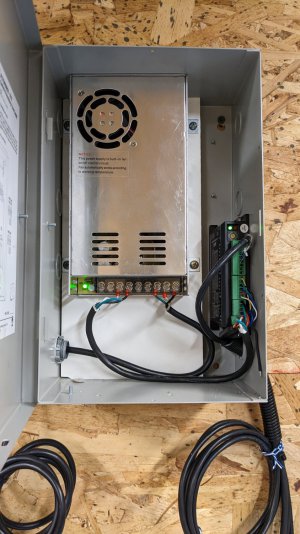-
Welcome back Guest! Did you know you can mentor other members here at H-M? If not, please check out our Relaunch of Hobby Machinist Mentoring Program!
You are using an out of date browser. It may not display this or other websites correctly.
You should upgrade or use an alternative browser.
You should upgrade or use an alternative browser.
Stepper control packaging
- Thread starter kmanuele
- Start date
- Joined
- Jan 25, 2022
- Messages
- 129
nice and clean.Pic of insideView attachment 446816
Stepper control cables are shielded. Needs a bit more cable management but fully functional as is.
Looks like a closed box, though lots of surface area. No cooling issues?
K
The fan is still in the power supply and when the door is closed it's not air tight so it does circulate some air. I have a fan filter screen i can install if it does overheat but so far it hasn't needed it. That would involve taking it back down, cutting a square hole in the box and then putting it all back together which is a hassle if not needed and the reason that the wiring and cable management is "temporary" so far. I also only run it for an hour or so at a time as i'm a hobbyist. I made sure to bolt the stepper driver to the metal case with both the back and side touching the case as to act as large of a heat sink as possible because that's the part that is most likely to overheat.
- Joined
- Jan 25, 2022
- Messages
- 129
The fan is still in the power supply and when the door is closed it's not air tight so it does circulate some air. I have a fan filter screen i can install if it does overheat but so far it hasn't needed it. That would involve taking it back down, cutting a square hole in the box and then putting it all back together which is a hassle if not needed and the reason that the wiring and cable management is "temporary" so far. I also only run it for an hour or so at a time as i'm a hobbyist. I made sure to bolt the stepper driver to the metal case with both the back and side touching the case as to act as large of a heat sink as possible because that's the part that is most likely to overheat.
yeah. Was just adding commentary --- I'm sure you won't have any problems. The fan will circulate air inside the box, and aluminum is a great heat conductor.
Appreciate the dialog.
- Joined
- Oct 29, 2012
- Messages
- 1,387
I do like soldered leads but unless you have a solder pot and a load of wires prepared, it doesn't make much sense to me. Job takes twice as long and isn't any better for it.Stranded wires into clamp terminals are pre-soldered.
What business was that? And what was the debate? I've serviced plenty of panels built by people in the 80s (and 90s, 2000s, and forward) built by folks who weren't big fans of ferrules. Or soldering. Just cramming wires into holes and calling it done. That's fast, half the time of using ferrules, and you can cram more wires into a given hole that way, saves terminals and jumpers. But you can only cleanly cram those wires once. Anyone down the line who needs to pull that wire out is going to withdraw a clutch of pubes and if they're as hamfisted as some the maintenance guys I've known, they'll just cram those pubes right back in the hole, now pointed down, left, right, some strands straying into neighboring terminals, causing nonsensical issues for someone else to figure out. So I am a big fan of ferrules and curious why anyone else wouldn't be.Not a big fan of ferrules -- a subject of debate back in the 80s in my business.
At the Dutch CNC zone this is discussed also. Seems the Dutch electronic guys have consensus in not to solder stranded wires. Great to hear the specialists have opposite opinions.Stranded wires into clamp terminals are pre-soldered. Not a big fan of ferrules -- a subject of debate back in the 80s in my business.
In the 80's it was soldering. Somewhere around 2000 it was changed to crimping.
The 2 most mentioned reasons for soldering or crimping:
soldering can make for better connection, but what happens some of the solder runs back from the terminal into the wire making it more brittle and conditions for breaking off.
Better soldering than bad crimping
- Joined
- Jan 25, 2022
- Messages
- 129
Long winded response (be careful what you ask forI do like soldered leads but unless you have a solder pot and a load of wires prepared, it doesn't make much sense to me. Job takes twice as long and isn't any better for it.
What business was that? And what was the debate? I've serviced plenty of panels built by people in the 80s (and 90s, 2000s, and forward) built by folks who weren't big fans of ferrules. Or soldering. Just cramming wires into holes and calling it done. That's fast, half the time of using ferrules, and you can cram more wires into a given hole that way, saves terminals and jumpers. But you can only cleanly cram those wires once. Anyone down the line who needs to pull that wire out is going to withdraw a clutch of pubes and if they're as hamfisted as some the maintenance guys I've known, they'll just cram those pubes right back in the hole, now pointed down, left, right, some strands straying into neighboring terminals, causing nonsensical issues for someone else to figure out. So I am a big fan of ferrules and curious why anyone else wouldn't be.
FWIW, I worked in the passenger rail vehicle and industrial hydraulic businesses for 40 years, from which I've retired.
re: solder.
These small stranded wires and these types of terminals need either solder or ferrules.
Takes literally only a few seconds for me to tin one or several wires at a time, as quick or quicker than crimping -- and I don't have to buy ferrules and another specialty crimper. I'm just a hobbyist - not a manufacturer.
re: ferrules. This is kind of apples and oranges compared to above because of wire sizes involved, but the basis of my comment:
In the 80s, the rail industry transitioned from traditional stud and bolt terminal strips, ring-lug terminals, etc, to modern fully enclosed screw terminal designs introduced by Euro suppliers like Wiedmuller (or later, spring clamps like Wagos). These were designed to accept bare wire directly. US customers initially expressed concern of wire bird-caging, stray strands, and maintenance. So, a few required ferrules in their new fleets.
But the US customer base eventually accepted that ferrules addressed a mostly non-existent problem. The terminal block design largely prevents stray strands from shorting to adjacent terminals. Wires removed readily go back in -- most of the time
Removing wires from terminal blocks is very infrequent, as most equipment is connectorized.
In the event of a rat's nest that can't be re-inserted, clip it off, strip, put it back in. No terminals or crimpers required. How likely to happen more than once to the same wire over the life of the equipment? Regardless, we always required enough slack in wire dress for at least 3 re-terminations.
Most maintainers I've worked with are responsible and proud of their work. Maybe your experiences have been different.
I no longer have access to my company files, but I found a poor photo of a partially terminated electric locker at one end of a streetcar -- a comparatively simple vehicle (can't operate in trains). No ferrules. There are upwards of a thousand terminations in a typical rail vehicle, so 100s of thousands in a big fleet purchase. With that many terminations, one would expect problems due to lack of ferrules would show up in testing, commissioning, or later in service. They just don't.
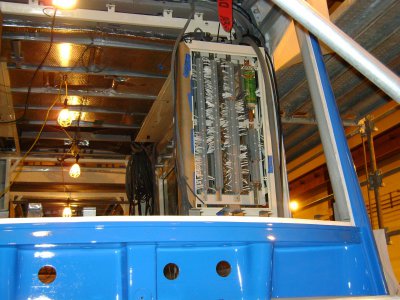
- Joined
- Oct 29, 2012
- Messages
- 1,387
You could say thatMost maintainers I've worked with are responsible and proud of their work. Maybe your experiences have been different.
I work on control systems for production machines in manufacturing plants. 50% design/build/program and 50% 3rd party field service on existing systems. When I get a field service call, it means my customer's maintenance guys have already taken turns trying to fix the thing and either got nowhere or made it worse. And often it's because a long line of equally skilled technicians have also taken turns over the years, making nonsensical and undocumented wiring changes. So that pretty streetcar picture you showed is not what I see on a regular basis. I'm more likely to open a panel and see some of this lucrative nightmare:
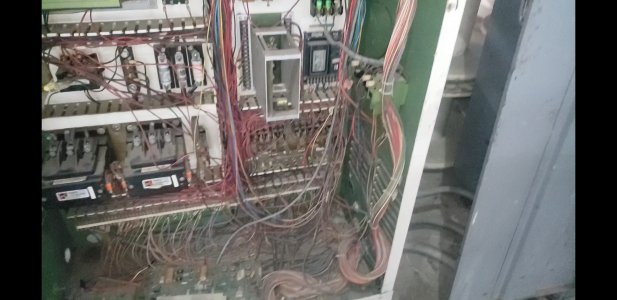
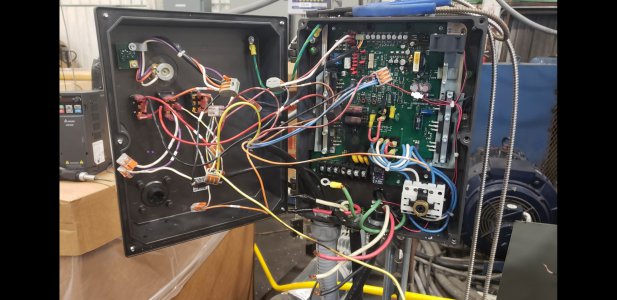
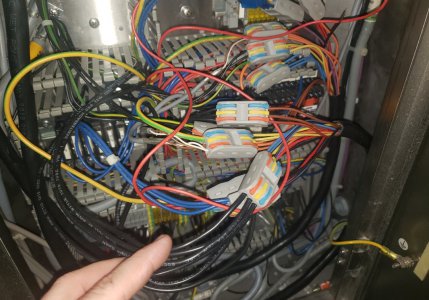
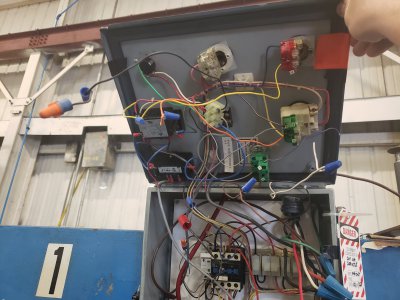
Note that I am talking about 16 awg wires and larger, so they have some rigidity.
Ok, I'm on the same page with you then. There are 16 awg and larger wires (continuous flex, welding lead, etc.) That aren't so rigid and could benefit as well, but those are not so common.These small stranded wires and these types of terminals need either solder or ferrules.
What is common though, is people who don't think like you or me. They just cram wires.
I started backing up the pictures I take on my phone to Google drive a couple of years ago and doing that allows me to search them by keyword, because Google AI can interpret what's in the pictures. I just searched through my pictures for "wires" and found almost 40 examples of this and compiled them into an album. For everyone's viewing pleasure:
Shitty wiring - Google Drive
 drive.google.com
drive.google.com
These pictures are all of issues I observed that either did happen, or were just one good fart/sneeze away from happening, and this is what I was picturing when you first started talking about not being a big fan of ferrules.
Takes literally only a few seconds for me to tin one or several wires at a time, as quick or quicker than crimping -- and I don't have to buy ferrules and another specialty crimper. I'm just a hobbyist - not a manufacturer.
Fair enough, if you can solder that fast, no reason not to. I might just be abnormally slow at it. Issue is I need 3 hands and have only 2.
Thanks for the explanation .In the 80s, the rail industry transitioned from traditional stud and bolt terminal strips, ring-lug terminals, etc, to modern fully enclosed screw terminal designs introduced by Euro suppliers like Wiedmuller (or later, spring clamps like Wagos). These were designed to accept bare wire directly. US customers initially expressed concern of wire bird-caging, stray strands, and maintenance. So, a few required ferrules in their new fleets.
But the US customer base eventually accepted that ferrules addressed a mostly non-existent problem. The terminal block design largely prevents stray strands from shorting to adjacent terminals. Wires removed readily go back in -- most of the time. Note that I am talking about 16 awg wires and larger, so they have some rigidity.
Removing wires from terminal blocks is very infrequent, as most equipment is connectorized....How likely to happen more than once to the same wire over the life of the equipment?
In my industry it's different. Guy sees PLC output card, no lights on. He assumes the card is bad, pulls all 20 wires off, replaces with dubious spare card from dusty shelf. Still no lights. Guy buys new card on ebay, replaces again; again all 20 wires come off and go back on. Still no lights. Now PLC has a fault. By the time I get there, wires have been pulled and re-crammed no less than 5 times, PLC fault due to different card firmware, update hardware configuration, no more fault. Find the problem was an e-stop, fix it, now new issues, random things coming on. Find wires not terminated to card in proper order and several whiskers contacting other wires, turning on multiple outputs out of sequence. (For example). Things like this happen all the time. Wires might be pulled off a given terminal and crammed back into it multiple times per year, and often it's done with power on, so nobody is massaging the wires straight, they just cram them home and torque them down, don't even bother checking for whiskers. Ever.
yes, it is (should be) that easy. I agree. Doing that is easy just like it's easy to throw away the cereal box when it's empty. But does anyone ever actually do that? Not in my house! When I have the random impulse once or twice a month to have a bowl of cereal I find the illusion of 5 or more choices all turn out to be empty, and the milk is expired.In the event of a rat's nest that can't be re-inserted, clip it off, strip, put it back in. No terminals or crimpers required.
Ha! It sounds like you're referring to a service loop? I have an empty box of service loops on my cereal shelf....Regardless, we always required enough slack in wire dress for at least 3 re-terminations.
Either my experience is uncommonly bad, or yours is uncommonly good. Probably both. Maybe I should look into the rail industry. I might pull out less hair out there.There are upwards of a thousand terminations in a typical rail vehicle, so 100s of thousands in a big fleet purchase. With that many terminations, one would expect problems due to lack of ferrules would show up in testing, commissioning, or later in service. They just don't.
- Joined
- Jan 25, 2022
- Messages
- 129
You could say that.
I work on control systems for production machines in manufacturing plants. 50% design/build/program and 50% 3rd party field service on existing systems. When I get a field service call, it means my customer's maintenance guys have already taken turns trying to fix the thing and either got nowhere or made it worse. And often it's because a long line of equally skilled technicians have also taken turns over the years, making nonsensical and undocumented wiring changes. So that pretty streetcar picture you showed is not what I see on a regular basis. I'm more likely to open a panel and see some of this lucrative nightmare:
View attachment 446943
View attachment 446944
View attachment 446945
View attachment 446946
Ok, I'm on the same page with you then. There are 16 awg and larger wires (continuous flex, welding lead, etc.) That aren't so rigid and could benefit as well, but those are not so common.
What is common though, is people who don't think like you or me. They just cram wires.
I started backing up the pictures I take on my phone to Google drive a couple of years ago and doing that allows me to search them by keyword, because Google AI can interpret what's in the pictures. I just searched through my pictures for "wires" and found almost 40 examples of this and compiled them into an album. For everyone's viewing pleasure:
Shitty wiring - Google Drive
drive.google.com
These pictures are all of issues I observed that either did happen, or were just one good fart/sneeze away from happening, and this is what I was picturing when you first started talking about not being a big fan of ferrules.
Fair enough, if you can solder that fast, no reason not to. I might just be abnormally slow at it. Issue is I need 3 hands and have only 2.
Thanks for the explanation .
In my industry it's different. Guy sees PLC output card, no lights on. He assumes the card is bad, pulls all 20 wires off, replaces with dubious spare card from dusty shelf. Still no lights. Guy buys new card on ebay, replaces again; again all 20 wires come off and go back on. Still no lights. Now PLC has a fault. By the time I get there, wires have been pulled and re-crammed no less than 5 times, PLC fault due to different card firmware, update hardware configuration, no more fault. Find the problem was an e-stop, fix it, now new issues, random things coming on. Find wires not terminated to card in proper order and several whiskers contacting other wires, turning on multiple outputs out of sequence. (For example). Things like this happen all the time. Wires might be pulled off a given terminal and crammed back into it multiple times per year, and often it's done with power on, so nobody is massaging the wires straight, they just cram them home and torque them down, don't even bother checking for whiskers. Ever.
yes, it is (should be) that easy. I agree. Doing that is easy just like it's easy to throw away the cereal box when it's empty. But does anyone ever actually do that? Not in my house! When I have the random impulse once or twice a month to have a bowl of cereal I find the illusion of 5 or more choices all turn out to be empty, and the milk is expired.
Ha! It sounds like you're referring to a service loop? I have an empty box of service loops on my cereal shelf.
Either my experience is uncommonly bad, or yours is uncommonly good. Probably both. Maybe I should look into the rail industry. I might pull out less hair out there.
Thanks for the dialog.
In closing, and for your amusement, here's a couple of extremes from the "cable art" category.
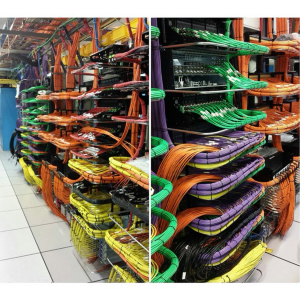
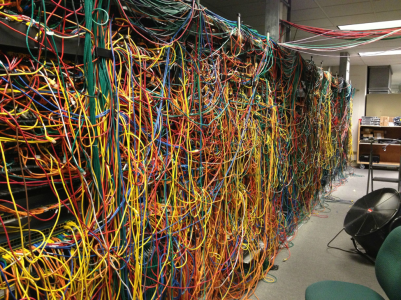
- Joined
- Dec 18, 2019
- Messages
- 7,333
Wow! So, laughing a bit, which one's were easier to work on? Might not be the one's we expect...Thanks for the dialog.
In closing, and for your amusement, here's a couple of extremes from the "cable art" category.
View attachment 446978View attachment 446979

